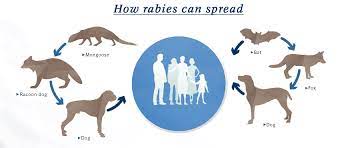Rabies: A Fatal Zoonotic Disease
Punam 1*, Kapil Kumar Godara 2, Rohit Juneja3
1*Veterinary Officer, Veterinary Hospital Jakheda, Nagaur (Rajasthan)
2 M.V.Sc Scholar, Livestock Products Technology, College of Veterinary and Animal Science, Bikaner (RAJUVAS, Bikaner) Rajasthan
3 Veterinary Officer, Veterinary Hospital Pundlota, Nagaur (Rajasthan)
Introduction
Rabies is a highly fatal viral disease. It is also a zoonotic disease that means it can transmit from animals to human. The type of zoonosis is direct anthropozoonosis. Most often it seen in stray dogs and some wild animals like bats, raccoons, skunks, and foxes. It usually transmitted in humans by biting or scratching of these infected animals. Dogs are the source of the huge majority of human rabies deaths, contributing up to 99% of all rabies transmissions to humans. In india rabies is endemic and contribute 36% of total world rabies deaths. The rabies virus affects central nervous system. It cause encephalitis in brain and death may occur in severe case. World Rabies Day is celebrated every year on 28 September.
Etiology
- Causative agent of rabies is Lyssa virusof rhabdoviridae Family. It is bullet shaped virus and neurotropic in nature.Rabies viruses are extremely fragile viruses
Transmission
- Saliva of infected dog is most common source of rabies transmission because very high concentration of rabies virus liberated from the salivary gland discharges before the onset of clinical signs of rabies.
Clinical signs
- The progressive sign of rabies mainly divided into two forms such as Furious form and dump form or paralytic form
- Dog and cat
The incubation period in natural outbreak of dog rabies averages from 3-8 weeks. But it can be from 10 days to years. In cat, furious form is more common.
- Furious form(changes in behaviour and stage of excitement)
- Dog become very furious and have tendency to biteeither inanimate or animate objects till death
- Dog may move to long distance
- They will Shows imaginary catching stance
- Dog will try to lick water but unable to drink water due to the paralysis of pharyngeal and laryngeal muscles
- Drooling of saliva.
- Photophobia (fear of light)
- Changes in barkingdue to paralysis of vocal cards
- Finally, the jaw is dropped and tongue will protrude and head will drop down
- Dump form or paralytic form
- Isolated themselves in dark places due to photophobia
- Paralysis of lower jaw (“dropped jaw”), tongue, larynx and hindquarters
- Not capable to bite due to dropped
- In terminal phase death due to respiratory paralysis
2.Cattle
Furious form
-
- Aggressively attack other animals or inanimate objects
- Loud bellowing
- Incoordination of gait
- Excessive salivation
- Behavioral changes
- Tremor in Muzzle
- Aggression in behaviour
- Sexual excitement
- Hyperexcitability
- Pharyngeal paralysis
Paralytic form
-
-
- Knuckling of hind fetlock
- Sagging and swaying of hind quarter while walking
- Deviation of tail to one side
- Drooling of saliva
- Yawing movement
-
3.Horse
- Muscle tremors are frequent and common
- Pharyngeal paralysis, ataxia and lethargy
- Sudden onset of lameness in one limb followed by recumbency
- Violent head tossing
4.Man
There is usually a history of animal bite.
- Pain appears at the site of the bite, followed by paresthesias (burning sensation).
- Pain and irritation at the site of bite which is travelling towards the central nervous system.
- The rabies virus travels from the peripheral nerves to the brain by following bite by a rabid animal.
- The incubation period of the disease is usually a few months in humans (usually 30 to 60 days), depending on the distance of bite, severity of bite, amount of virus inoculated at the site of bite and aggressive status of the rabid animal.
- Once the rabies virus reaches the central nervous system, it cause encephalitis in brain and show centrifugal transmission and symptoms begin to show.
- The infection is effectively untreatable and usually fatal within days.
- Death almost invariably results two to ten days after first symptoms.
- Attempts at drinking cause extremely painful laryngeal spasm, so that the patient refuses to drink (“hydrophobia” – fear of water).
- The patient is restless and behaves in a peculiar manner.
- Muscle spasm, laryngospasm and extreme excitability are present.
- Convulsions occur.
- Large amounts of thick tenacious saliva are present.
- There will be increased lacrimation,
- Frequent micturition and
- Increased percipiration.
Diagnosis
- Consider rabies as a possible problem in any animal of unknown vaccination history showing central nervous system signs or symptoms.
- Fluorescent antibody test (FAT)with corneal impression smear, as well as brain. FAT is highly specific and rapid test (99.9%).
- Identification of Negribodies (intracytoplasmic inclusion bodies)in the brain impression smear by Seller’s staining technique.
Treatment after exposure
- Clean the wound and do immunizations, as soon as possible after suspect contact with an animal, can prevent the onset of rabies in virtually 100% of exposures.
- Post-exposure care to prevent rabies includes
- Washing and scrubbing the wound with phenolic soap and/or plenty of running tape water
- Application of antiseptics
- Avoiding bandaging or suturing of wound, or point of contact
- Administering anti-rabies vaccine as soon as possible.
Post exposure schedule
- If the animal is not previously immunized, post exposure vaccination on 0-day (the day starts within 24 hours after bite), 3rd, 7th, 14th, 28thand if necessary, on 90th day (Essen’s schedule).
Reference
- Martin, S. W., Meek, A. H., & Willeberg, P. (1987). Veterinary epidemiology: principles and methods. Iowa State University Press, Ames IA.
- Michael Thrusfield (2007). Veterinary Epidemiology, Third edition. Blackwell Science.


